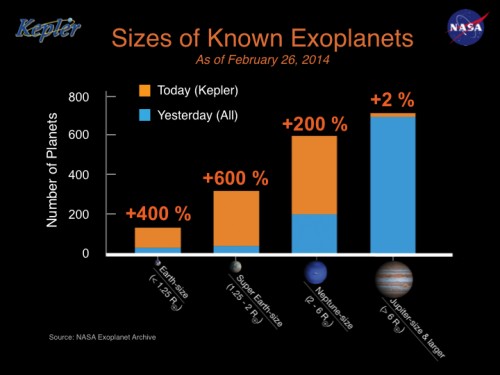
The latest haul of exoplanets is skewed towards Earth-like masses. (Courtesy: NASA)
By Hamish Johnston
Just a few years ago the idea that more than 700 exoplanets could be discovered in a single study would seem fantastical. But that’s exactly what astronomers working on NASA’s Kepler mission have just done.
By analysing data obtained by the space telescope between May 2009 and March 2011, the team has verified the existence of 715 exoplanets. This brings the total number of planets that orbit stars other than the Sun to nearly 1700.
Many of these recent discoveries were found in multiple-planet systems, suggesting that our solar system could be the norm. For those keen on finding life on other planets, four of the new exoplanets are less than 2.5 times the size of Earth and orbit within their star’s habitable zone.
Indeed, as the above image shows, this latest haul of exoplanets is skewed towards smaller bodies like the Earth. This is unlike earlier discoveries, which tended to be Jupiter-sized worlds that are easier to detect. As a result, it’s looking more likely that Earth-like planets could be very common in the local universe.
The results of the study will be published on 10 March in The Astrophysical Journal and are available as two preprints on the arXiv server: “Validation of Kepler’s Multiple Planet Candidates II” and “Validation of Kepler’s Multiple Planet Candidates III“.
Stay tuned to Physics World for more about what the climate could be like on exoplanets, and whether some could be suitable for life.
Guidelines
Show/hide formatting guidelines
this text was deletedwhere people live in harmony with nature and animals</q>
Some text